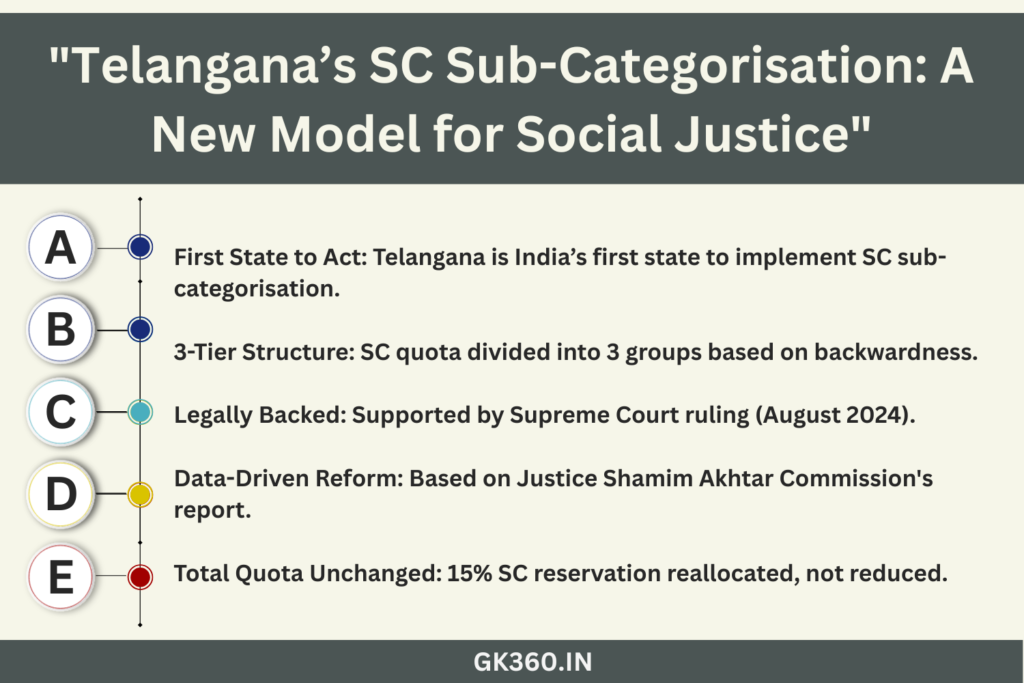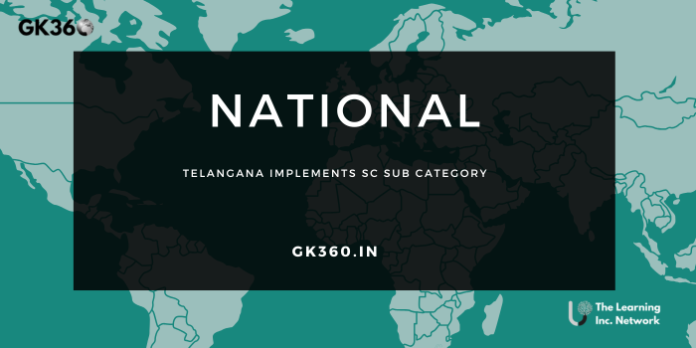Telangana Implements SC Sub-Categorisation: A Landmark in Social Justice Reform
Introduction
In a landmark move toward targeted affirmative action, Telangana has become the first Indian state to implement Scheduled Castes (SC) sub-categorisation within its reservation system. The birth anniversary of Dr. B.R. Ambedkar, the policy aims to bring long-overdue equity to historically marginalized sub-castes within the SC category.
This progressive reform, backed by a Supreme Court ruling, introduces a group-wise reservation quota based on levels of social and educational disadvantage. By dividing the SC quota into three distinct groups, Telangana has taken a bold step toward precision-based social justice—setting a precedent that could influence national policies.

Table of Contents
- What is SC Sub-Categorisation?
- Legislative Milestones Behind Telangana’s Move
- Supreme Court’s Role and Legal Greenlight
- Structure of the New SC Reservation Framework
- The Shamim Akhtar Commission: Data-Driven Policy Design
- Reactions Across Political Spectrum
- National Implications and Outlook
- Frequently Asked Questions (FAQs)
- Conclusion: A New Era of Targeted Affirmative Action
What is SC Sub-Categorisation?
SC Sub-Categorisation refers to the internal classification of Scheduled Castes into smaller, more defined groups within the existing reservation framework. The goal is to ensure equitable distribution of benefits, particularly for those sub-castes that have remained marginalised even within the SC category.
Instead of a single, blanket quota for all SCs, Telangana’s approach allocates specific percentages to three groups based on:
- Literacy and education levels
- Employment and economic status
- Representation in politics and administration
- Historical neglect
This approach aligns with modern views on affirmative action—which emphasize data-driven and targeted support.
Legislative Milestones Behind Telangana’s Move
Telangana’s journey toward SC sub-categorisation began with the Scheduled Castes (Rationalization of Reservations) Act, 2025, which was:
- Passed by the Telangana Assembly on March 18, 2025
- Signed by the Governor on April 8, 2025
- Officially notified on April 14, 2025, coinciding with Ambedkar Jayanti
This timing wasn’t accidental. Choosing Ambedkar’s birth anniversary gave the reform a symbolic and moral weight, reinforcing its goal of justice for the most disadvantaged communities.
Supreme Court’s Role and Legal Greenlight
The legal legitimacy of the reform stems from the Supreme Court judgment dated August 1, 2024, which ruled that states have the right to sub-classify SC communities within their reservation systems.
This judgment overturned previous legal uncertainties and set a constitutional precedent. Telangana is the first state to act upon this ruling, demonstrating a pioneering model of policy execution.
To ensure transparency and accuracy, the government also commissioned an independent study, appointing Justice Shamim Akhtar to head the review.
Structure of the New SC Reservation Framework
While retaining the total SC reservation at 15%, Telangana’s model introduces a tiered structure, dividing the 59 SC sub-castes into three groups. This structure reflects a graduated scale of backwardness:
| Group | Number of Communities | Population Share | Reservation Quota |
|---|---|---|---|
| Group 1 | 15 (most disadvantaged) | 3.288% (~1.71 lakh) | 1% |
| Group 2 | 18 (moderately backward) | 62.74% (~34 lakh) | 9% |
| Group 3 | 26 (relatively better-off) | 33.963% (~17 lakh) | 5% |
Each group was determined based on socio-economic indicators such as education, income, employment, and representation levels.
Group 1: Most Disadvantaged
This group includes 15 sub-castes with the least access to education and employment opportunities. For example:
- Communities like Budiga Janga fall into this group due to chronic neglect in policy access.
- Many in this group lack political representation or economic stability.
They now receive 1% out of the total 15% SC quota—a step designed to create entry points into education and jobs.
Group 2: Moderately Backward
With 18 communities, this group includes castes with:
- Low but improving literacy rates
- Minimal access to skilled jobs
- Some representation in administrative roles
They comprise the majority of the SC population (62.74%) and will receive 9% of the total quota.
Group 3: Relatively Better-off
Consisting of 26 sub-castes, Group 3 includes communities with:
- Higher literacy and employment levels
- Better access to political platforms
- Greater awareness and mobility
They receive the remaining 5% of the SC reservation quota.
The Shamim Akhtar Commission: Data-Driven Policy Design
To ensure that sub-categorisation was based on rigorous research and community input, the Telangana government formed a one-man commission in October 2024, headed by Justice Shamim Akhtar.
Key highlights:
- 8,600+ representations received from various communities.
- Extensive consultation sessions and field studies conducted.
- Final recommendations were submitted before April 2025 and formed the basis of the official categorisation.
Justice Akhtar’s report is being lauded as a blueprint for evidence-based policy in affirmative action.
Reactions Across Political Spectrum
Voices of Concern
CPI MLA Kunamneni Sambasiva Reddy raised concerns over the classification of the Rella community under Group 3. He argued that the placement did not adequately reflect their economic hardship and social exclusion.
Proposals for Further Refinement
AIMIM MLA Majid Hussain suggested:
- Expanding the classification to four groups for greater nuance.
- Increasing the total SC reservation to 18% to align with Telangana’s 17.5% SC population share.
Government’s Defense
Government officials countered these concerns, stating:
- Three categories strike the right balance between justice and administrative feasibility.
- A two-group model could skew benefits toward larger groups, while a four-group model would be too complex to implement.
Civil Supplies Minister N Uttam Kumar Reddy clarified that:
- This is not an introduction of a creamy layer within SCs.
- No existing benefits would be taken away.
- After the 2026 Census, the overall SC reservation percentage might be revised to reflect population growth.
National Implications and Outlook
Telangana’s move could influence other Indian states and spark nationwide discussions on intra-reservation justice. With a Supreme Court-backed framework and data-driven execution, this model offers a replicable template for:
- Correcting historical imbalances within caste-based reservations.
- Promoting targeted welfare using social indicators, not just identity markers.
- Advancing India’s evolving vision of inclusive affirmative action.
This marks a significant policy innovation in India’s complex reservation landscape.

Frequently Asked Questions (FAQs)
- What is SC sub-categorisation?
It is the internal division of Scheduled Castes into smaller groups within the existing reservation quota to ensure more equitable distribution of benefits based on their actual levels of disadvantage. - Why did Telangana implement this policy?
To address the concern that more influential or better-off SC sub-castes were monopolizing the 15% reservation benefits, leaving the most marginalized behind. - What is the legal basis for SC sub-categorisation?
A Supreme Court judgment dated August 1, 2024, allowed states to internally classify SC communities for targeted reservation benefits. - Will existing SC reservations be reduced for any group?
No. The policy reallocates the existing 15% quota into three parts without reducing anyone’s entitlements. - Could this model be implemented in other Indian states?
Yes. The Telangana model, being legally and empirically grounded, could serve as a framework for other states interested in equity-based sub-classification.
Conclusion: A New Era of Targeted Affirmative Action
With the rollout of SC sub-categorisation, Telangana has redefined the future of reservation policy in India. This bold reform acknowledges the internal diversity within Scheduled Castes and introduces a system where justice is not just symbolic but quantifiable.
By implementing data-backed, legally sound, and socially responsive measures, Telangana is leading the way in making affirmative action smarter, fairer, and more inclusive.
Key Takeaways Table
| Aspect | Details |
| Policy Innovation | Telangana becomes the first state to implement SC sub-categorisation. |
| Legal Foundation | Enabled by Supreme Court ruling on August 1, 2024. |
| Reservation Model | 15% SC reservation split into 3 groups based on backwardness. |
| Sub-Caste Grouping | Group 1: 1% (most disadvantaged), Group 2: 9%, Group 3: 5%. |
| Commission Involvement | Justice Shamim Akhtar Commission led the data-backed classification. |
| Reactions & Criticisms | Some MLAs questioned group placements; government defended 3-group model. |
| National Impact | Telangana’s model could inspire similar reforms across Indian states. |





